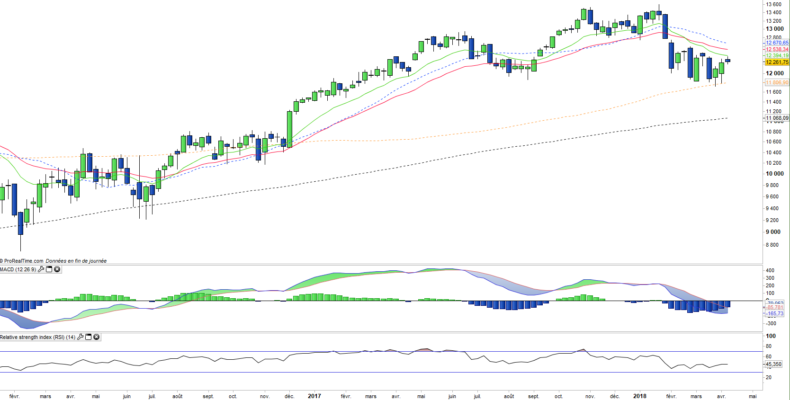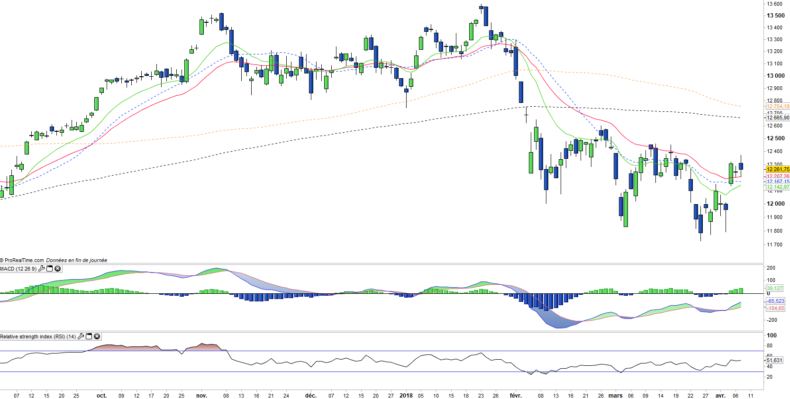DB X-Trackers (DBXD) - 10/04/2018
Short Term strategy: Negative (20%) / Trend =
Long Term strategy: Neutral (50%) / Trend -
Characteristics of the ETF
The DBXD ETF (db x-trackers), quoted in Euro, replicates the DAX 30 index which is composed of the 30 largest listed German securities, representative of the main sectors of the economy, while the stocks are selected according to the importance of their market capitalization.
The costs of this ETF are low at 0.09% and AUM is quite high at 3900M €, which makes it one of the best vehicles in terms of costs / liquidity. The replication method is direct (physical) and the dividend distribution is capitalized.
Alternative ETFs: DAX (Lyxor in Euro), DAXEX (iShares in Euro)
Latest developments
After an increase of 6.9% in 2016, the DAX30 grew by 12.5% in 2017, more than the stoxx600 (+ 10.6%).
The index fell by -5.1% since the beginning of the year after a sharp correction on the US markets which is a lower performance than the Stoxx600NR (-2.9%). Despite a relative resistance of the automobile sector, the DAX has undergone a strong correction related to some key companies like SAP (-6.5%), Siemens (-9.6%) or Deutsche Bank (-27.6%). Apart from the specific problems of Deutsche Bank, the big German export companies are seen by the market as more vulnerable to protectionist actions coming from the United States or China and more dependent on the world economy.
The German economy is based on exports and has everything to lose in a trade war and the general increase of tariffs. The index is therefore particularly vulnerable now, especially since D.Trump has already threatened the German industry accused of manufacturing trade surpluses to the detriment of the United States.
In addition, a number of social movements are taking place in large companies to demand wage increases that could weigh on margins (Lufthansa, Deutsche Post, etc.).
Index & components
The top 10 stocks are mainly large industrial stocks such as Siemens or Bayer, while there are only 3 financial stocks: Allianz, Commerzbank and Deutsche Bank, the German master index is relatively small and mostly composed of large industrial groups. Unlike the English, French or Italian indices, the DAX is also distinguished by the absence of large oil companies that weigh heavily in the weighting of the CAC40, FTSE100 or FTSEMIB40, which is double-edged according to the cycle specific to energy sector. In addition, the financials weigh only 16.6% of the index, half for the insurance giant Allianz, so the banking sector has a low weight reflected in the well-known weakness of Deutsche Bank and Commerzbank. Conversely, the automotive and chemical sectors are heavier than the other European indices, while the technology sector is mainly represented by SAP (9.2%) whose market capitalization exceeds € 100 billion.
In summary, the DAX is a fairly strong index from a sectoral point of view which can make it evolve differently from other European indices. German fundamentals are very solid (GDP growth above 2%, historically low unemployment rate at 5.5% and accelerated deleveraging up to 2020).
The main risks concern Germany's main customers, namely the United Kingdom, which could suffer from Brexit, the US in political uncertainty and threatening it with a trade war, Russia which remains a difficult and aggressive neighbor and China because of its commercial practices which also tend to limit access to its domestic market to Western industrialists, particularly in the automotive and technology sector
Weekly data
On the weekly chart, we can observe a stabilization of the index on the EMA100 which allows momentarily to stop the downward momentum. However, the formation of a rebound is slow while prices remain below short moving averages (EMA13 & 26). The hour of truth is approaching, namely that the index will now have to choose between going back over its short moving averages or crossing its EMA00 down. The oversold state of technical oscillators argues instead for a rebound.
Daily data
The daily chart shows the current recovery attempt on the DAX30. The prices have just returned above the EMA13 and 26 which validates a first step of recovery of the short term trend. But the EMA100 still acts as a major resistance, and only its overrun can be considered a buy signal. An upward crossing between EMA13 & 26 would bode well for the current movement.
ETF Objective
DBXD is a UCITS ETF which replicates the DAX index (30 german companies)
Characteristics
| Inception date | 10/01/2007 |
| Expense ratio | 0,09% |
| Issuer | Lyxor |
| Benchmark | Indice DAX 30 |
| Code/Ticker | DBXD |
| ISIN | LU0274211480 |
| UCITS | Yes |
| Currency | € |
| Exchange | XETRA |
| Assets Under Management | 3 900 M€ |
| Replication method | Direct (Physical) |
| PEA (France) | No |
| SRD (France) | No |
| Dividend | Capitalization |
| Currency risk | No |
| Number of Holdings | 30 |
| Risk | 3/5 |
Country Breakdown
| Germany | 100% |
Sector Breakdown
| Consumer discretionary | 19% |
| Financials | 17% |
| Materials | 15% |
| Industrials | 13% |
| Health Care | 13% |
| Technology | 12% |
| Telecom | 4% |
| Others | 8% |
Top Ten Holdings
| Siemens | 9% |
| SAP | 9% |
| Bayer | 8% |
| BASF | 8% |
| Allianz | 8% |
| Daimler | 6% |
| Deutsche Telekom | 4% |
| Adidas | 4% |
| Deutsche Post | 3% |
| Volkswagen | 3% |


